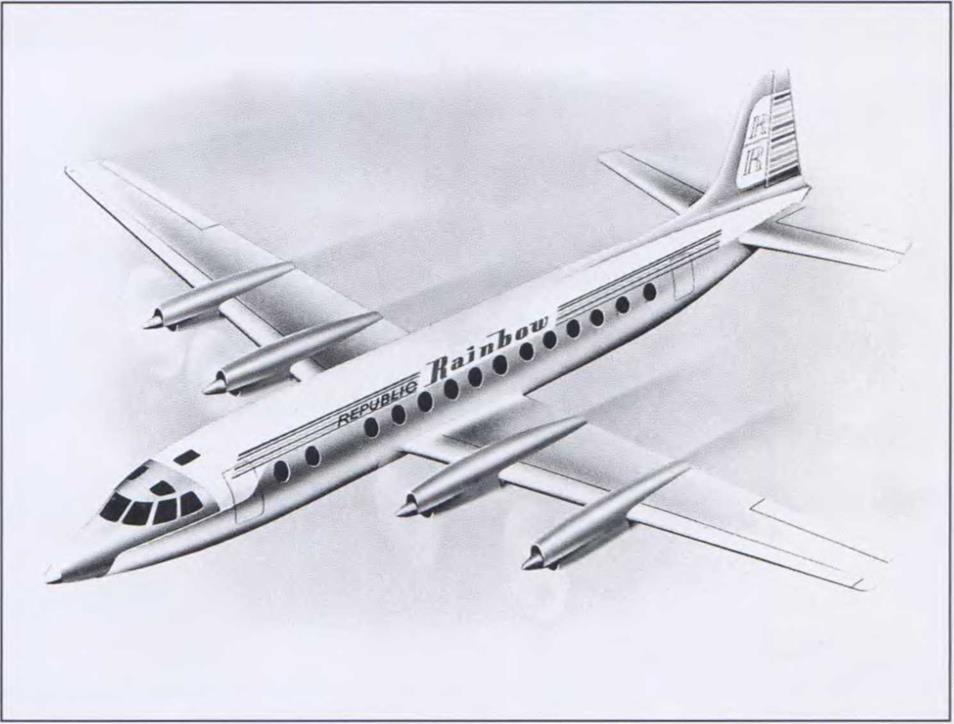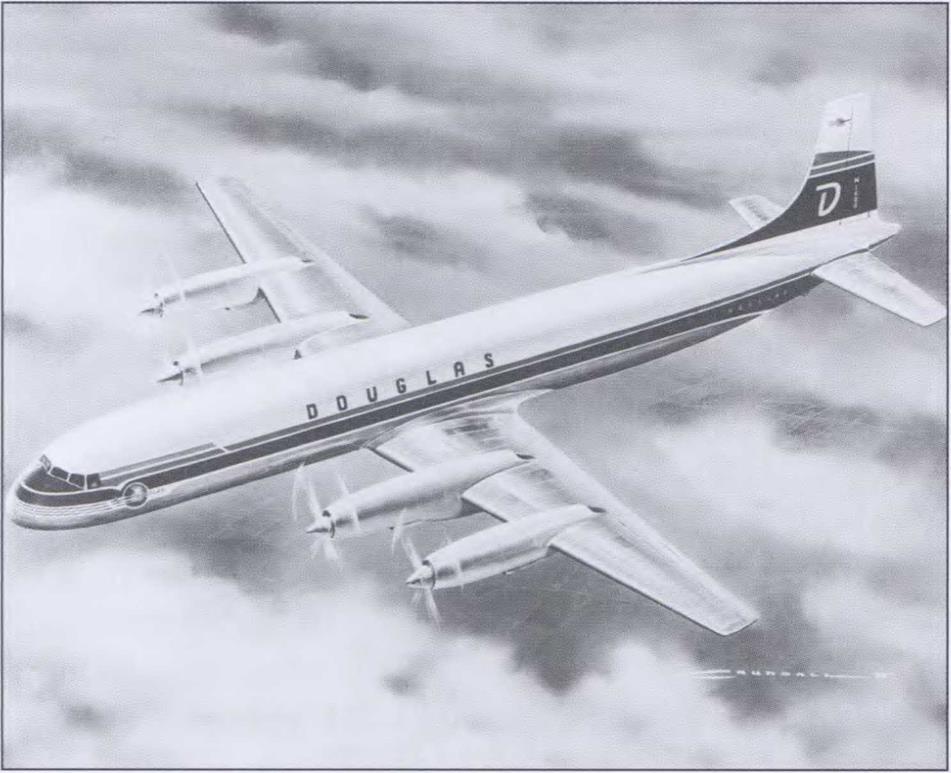Decisions, Decisions
In Britain, turboprops already ruled the airways, from the small Miles Marathon to the gigantic Saunders-Roe Princess flying boat. Short or long range, these new hybrid engines flew on them all. In America, many major aircraft manufacturers were contemplating and developing their own turbine-propeller-powered airframes. There was the giant XC-132 cargo carrier from Douglas, and even Boeing’s first B-52 strategic bomber design concept was a turboprop! All existing airplanes were being designed around future turboprop powerplants (as noted in the sections on Lockheed’s Constellation series). But these same companies were also concurrently thinking pure jet, which brings us to the DC-7D.
As early as 1952, Douglas had secretly established a jet-engine airliner study group. For public consumption, however, and that of the airline chiefs, Douglas later offered rather half-heartedly what everyone considered a stopgap airplane powered by RB.109 turboprop engines from Rolls-Royce. The aircraft was based on the DC-7C airframe, but had a swept vertical stabilizer and a 40-inch fuselage stretch. C. R. Smith at American was interested, but at the urging of Art Raymond, Vice President of Engineering at Douglas, Donald Douglas made the decision to skip the turboprop and go directly to pure jet power. The result of that pivotal decision was the DC-8.
Facing all the other airliner manufacturers at that time was the very same choice Don Douglas had to
|
Remember the Republic RC-2 Rainbow shown on page 11 in Chapter One? This design concept was resurrected in the mid-1950s as a veritable "last gasp" from the company to attempt to harness the commercial airliner market. Looking like a cross between various aircraft designs from Vickers, Fokker, and Potez, the Turboprop Rainbow never left the drawing boards at Farmingdale. (Cradle of Aviation Museum Archives via Mike Machat Collection) |
make. Should they play the game by putting off the inevitable transition to pure jets and produce a turboprop airliner? If they did, they had to realize that the market was going to be medium to small at best. There was, therefore, every reason to believe that supplying such an airplane would be a money-losing proposition. And yet, if the manufacturers jumped right to jets with all their inherent risks, would the airlines be willing to jump with them?
In the meantime, minds were made up at American and Eastern Air Lines to ask for bids on a clean-sheet – of-paper turboprop design, with Lockheed’s Electra emerging as the winner of that competition. This suited Lockheed who had lost a “promised” contract for the Air Force’s new four-engine jet tanker, which steered them directly to the consolation prize of turboprop power. By mid-1955, American had signed on for 35 Electras while Eastern ordered 40.
While Boeing had flown its Dash 80 prototype and Douglas was planning its own new DC-8 Jetliner, airlines that wanted to hedge their jet bets bought Electras as well to “complement” their pending pure-jet fleet. Marketing logic dictated that the intermediate technology of the turbine-propeller would be just fine for flying from New York to Chicago, or even all the way from New York to Los Angeles, just in case the jets didn’t quite work out. As an aside, Western Airlines with its new route authority to Hawaii a few years later was quite willing to use Electras rather than buy or lease the 707. For Western, the Electra was the wonder
|
On the West Coast another stillborn concept was envisioned but then abandoned when Douglas decided to forge ahead with a pure-jet airliner called the DC-8. By not building the interim Douglas DC-7D Turboprop shown in this concept rendering, Douglas left the task of building America’s only turboprop-powered airliner to Lockheed with its Electra design. (Craig Kodera Collection) |
airplane of the era; such was its economy of operation, flexibility, and quasi-jet-like speed. Western did not order pure jets until 1960.
Once all was said and done in the saga of the turboprop in America, things turned out pretty much as expected. The British supplied the first round of airplanes: Viscounts to Capital and Northeast, where Britannias were also nearly a reality for both carriers. The Electra was built for the second round of equipment upgrades, delivering a larger airplane with greater range. With only 170 aircraft produced, however, the Electra program ultimately lost money, as predicted. At the smaller-size end of the spectrum, Fairchild license – built the twin-engine F-27 turboprop from Fokker for local service airlines, with a total of 129 coming from its Hagerstown, Maryland, plant.
By 1959, the surprising quality, reliability, and ready acceptance by passengers of the pure jets, combined with a sudden reality that more airline seats were needed in the market, accelerated the arrival of shorter – range jetliners such as the Caravelle, 720, 727, and finally, the DC-9 in the mid-1960s. This negated the need for further large turboprop designs, and early-on stifled sales of the Electra (and in Britain, the Vanguard). The F-27 soon became a victim of its own success in stimulating new traffic at the small airlines, for it rapidly became too small, and larger equipment was ordered rather than more of the basic F-27.
Truly niche aircraft, the turboprops of the 1950s provided a valuable transition, or “bridge,” in the progression from props to jets. But the window of opportunity was quite small, and for one manufacturer, Lockheed, the decision to spurn pure jets would have competitive ramifications for years to come, completely changing the dynamics of the market and its players in the new world order of commercial jet airliners.












